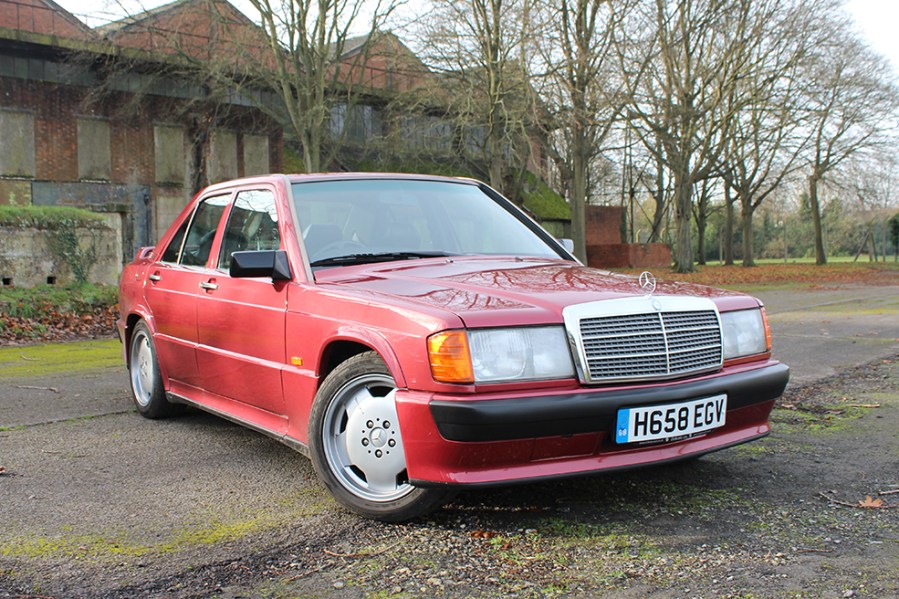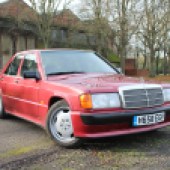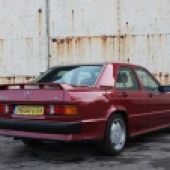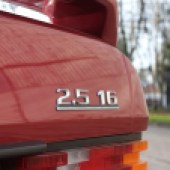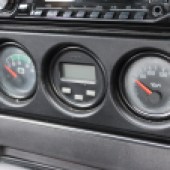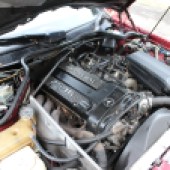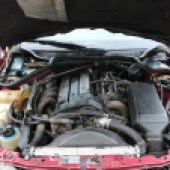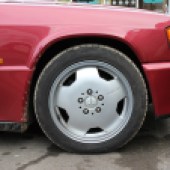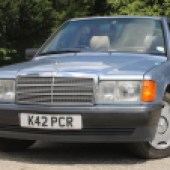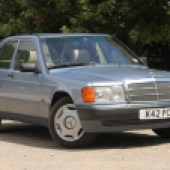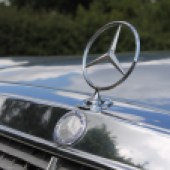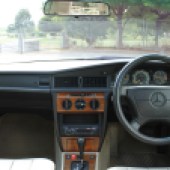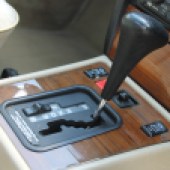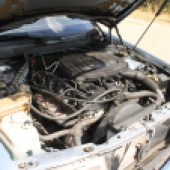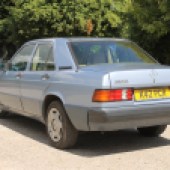An enticing mixture of solid build and modern engineering, the Mercedes 190E range has something for everyone. Here’s how to buy a great one
Words: Sam Skelton
The Mercedes 190E was the German brand’s first attempt to make a small saloon but wasn’t a flash in the pan. Development had taken almost a decade and £600m was spent perfecting the design before it was released to the public in 1982. Using the same 2.0-litre engine as the basic W123 in carburetted and injected forms, the new car adopted the 190 and 190E epithets to mark that it sat below the existing 200 in the range. From September 1983 the Mercedes 190E was exported to Britain, priced to compete with the 320i and 323i models from BMW’s E30 range.
In 1985, Britain got its first new engine – a 2.6-litre six-cylinder unit shared with the larger W124 260E. The Mercedes 190E 2.6 took the fight to the new BMW 325i, offering comfort and performance in one compact package. There was also a naturally aspirated five-cylinder diesel option – the 190D 2.5 – which earned itself a strong reputation for reliability and thrift even if it wasn’t the fastest.
In 1990 Mercedes replaced the carburetted 190 with a smaller injected engine, in the 190E 1.8. At the other extreme, BMW’s M3 saw competition in the form of the 190E 2.3-16 and subsequent 2.5-16, developed in conjunction with Cosworth. Merecedes 190E production ceased in 1993 after 1.8 million had been built; it was replaced by the Mercedes C-Class (W202).
Bodywork
As an old Mercedes, any 190E will rust – but equally because the trouble spots on the Mercedes 190E are well known, the odds are that on many they’ll have been treated already. There’s a rust trap ahead of the front wheel arch that leads to rot in the wings while sagging front bumpers can indicate similar issues; if you can, get your hand in and feel behind the panel. Rear subframe mounts can also rust and are worth checking.
Check the jacking points, particularly on late models with plastic cladding to their lower halves, as well as door bottoms. Likewise, check the floors if there’s any sign of underseal, as trapped water can rot the floors out behind the underseal in extreme cases.
Unlike the Mercedes W124 which shares underpinnings with the 190E, there’s only one body – if you want a convertible or an estate you’re out of luck, but the saloon is well styled and roomy enough for a family of four. Most had steel wheels with plastic trims when new but today many have been fitted with period-correct Mercedes alloy wheels. Cars so fitted will be more desirable when you come to sell.

Engine and transmission
For petrol Mercedes 190E models there are two engine families – the M102 four-cylinder and M103 six-cylinder, as fitted to the 190E 2.6. While you may have heard of 1990s Mercedes cars suffering from wiring loom issues, the good news is that these typically present on the next generation of engines and no 190E should be so afflicted. These engines – except for the Cosworth – all feature two valves per cylinder, and in all cases are known for their longevity. The four-cylinder models need a timing chain roughly every 60000 miles, while six-cylinder models can leak oil. It’s also worth checking for signs of basic maintenance – the quality of the HT leads, the cleanliness of the oil and so forth. A recent service can hide as much as it can show, so a car that looks used but has been regularly maintained is arguably the safest bet.
Diesel models are equally hardy in service, though by now many have been driven into the ground as taxis or exported to developing nations. They’re out there but owing to their rarity expect to pay a premium over a 1.8 or 2.0 petrol and expect a car that’s less engaging to drive.
Most Mercedes 190E models are automatic – and with good reason. It’s not that the manual is a bad gearbox, but the shift quality is sub-par for the price point and the market, in general, thinks a Mercedes should be automatic. The manual’s not unreliable or fragile, just undesirable – especially when Mercedes has long been at the forefront of automatic transmission design and use.
The Mercedes four-speed automatic used in all 190 models offers two modes – Standard and Economy, never ‘Sport’ in a Mercedes whatever any seller might try to suggest. Typically, in Standard the box begins in second unless you’re accelerating hard, so don’t be surprised if you only hear three shifts on a road test. Put your foot down from a slight rolling start and it should shift down into first perfectly well. In Economy, it’ll always start in second to promote fuel efficiency. Check for red transmission fluid – brown needs changing, while black probably means the box needs changing and you should walk. It’s possible to adjust the shift points by adjusting the Bowden cable, so if you think it’s shifting too early or late this can be corrected.
Suspension, steering and brakes
The coil springs and separate dampers are shared with the later and larger W124 model – a car that under the skin shares many components with the Mercedes 190E. Likewise, the multi-link rear suspension setup will be familiar to owners of later 1980s and 1990s Mercedes models. There’s nothing especially difficult to deal with here, so a brief inspection should be all that is necessary. Check both for free play and excessive tightness in the steering – either can indicate issues with the steering box that will require investigation.
Brakes are a simple system and shouldn’t pose any serious concerns. These are servo-assisted items and have discs on all four corners. Unlike many Mercedes models, the 190E had a conventional central lever operating the parking brake. For those new to Mercedes this will be easier to live with than the foot or dashboard operated brakes of its contemporaries.

Interior and trim
There are four basic materials available – cloth is most common, though velour was a rarely specified early option. Those seeking hard wearing trim could opt for the MB-Tex vinyl which has earned a name for itself as one of the hardiest interior materials in motoring, while those seeking luxury could opt for leather instead.
Sportline-equipped cars, including Cosworth models, came with a unique cloth material; Cosworth examples also had a contoured rear seat. In standard models, leather is perceived as the most desirable and thus the best if you’re buying with an eye on subsequent resale. Many have grey and cream trim – there are more interesting colours, but equally the rarer colours will prove harder to replicate should any trim need to be sourced later in ownership.
It’s also worth specifying here that air conditioning is a rarely specified but desirable option, and it will increase the value of any 190E by between 10 and 20% if it’s fitted and functioning.
Mercedes 190E: our verdict
While the Mercedes 190E was the brand’s first attempt at a smaller saloon, that doesn’t mean it’s any less capable for it. Not only does it offer one of the best value entry points into classic Mercedes ownership, but the Mercedes 190E feels every bit as solid and as hardy as a W123 or W126. There will almost certainly be corrosion given that most of these are now over 30 years old, but there’s nothing you can’t repair and there will be good cars out there if you look. And it appeals to all types of Mercedes buyer from the puritan 190 to the fully loaded 2.6, like the project car we ran some years ago.
It’s worth noting that there are Mercedes-Benz VIN decoders online, into which you can input a VIN and extract the original build sheet for the car. This will include any factory-fitted optional extras, such as provision for a radio, alloy wheels, a larger fuel tank, or air conditioning. Many of these cars have had replacement trim or alloys, or even more thorough upgrading over their lives – and knowing how it left the factory could be useful when it comes to negotiation over price. This build sheet will help you work out how original your car is, and act as a handy guide should you be trying to restore a sense of originality to a modified example.
For everyday use, we’d look for a good 190E 2.0 – or a 2.6 if we could afford the fuel bills. Diesel engines can return decent fuel economy but smaller-output petrol versions aren’t really adequate for an automatic model – and manual Mercedes don’t sell well in the future. Buy well and a good Mercedes 190E will outlive you.

